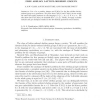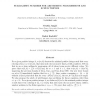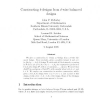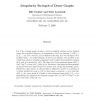APAL
2005
13 years 9 months ago
2005
Abstract. Let n be a positive integer and FA (n) be the free abelian latticeordered group on n generators. We prove that FA (m) and FA (n) do not satisfy the same first-order sente...
RSA
2006
13 years 9 months ago
2006
Let n be a positive integer and > 0 a real number. Let Vn be a set of n points in the unit disk selected uniformly and independently at random. Define G(, n) to be the graph w...
ENDM
2007
13 years 9 months ago
2007
For a given positive integer k, sr(m, k) denotes the minimal positive integer such that every coloring of [n], n ≥ sr(m, k), that uses each color at most k times, yields a rainb...
EJC
2007
13 years 9 months ago
2007
We give a construction to obtain a t-design from a t-wise balanced design. More precisely, given a positive integer k and a t(v, {k1, k2, . . . , ks}, λ) design D, with with all ...
JSC
2008
13 years 9 months ago
2008
Motivated by the famous 3n + 1 conjecture, we call a mapping from Z to Z residue-class-wise affine if there is a positive integer m such that it is affine on residue classes (mod m...
JSC
2008
13 years 9 months ago
2008
Let k be a field of characteristic zero, n any positive integer and let n be the derivation n i=1 Xi Yi of the polynomial ring k[X1, . . . , Xn, Y1, . . . , Yn] in 2n variables o...
JGT
2008
13 years 9 months ago
2008
Let G be a simple graph of order n with no isolated vertices and no isolated edges. For a positive integer w, an assignment f on G is a function f : E(G) {1, 2, . . . , w}. For a ...
CORR
2007
Springer
13 years 9 months ago
2007
Springer
We introduce two algorithms for accurately evaluating powers to a positive integer in floating-point arithmetic, assuming a fused multiply-add (fma) instruction is available. We ...
COMBINATORICS
2007
13 years 9 months ago
2007
The distinguishing number ∆(X) of a graph X is the least positive integer n for which there exists a function f : V (X) → {0, 1, 2, · · · , n−1} such that no nonidentity ...
COMBINATORICS
2007
13 years 9 months ago
2007
For a permutation π = π1π2 · · · πn ∈ Sn and a positive integer i ≤ n, we can view π1π2 · · · πi as an element of Si by order-preserving relabeling. The j-set of ...




